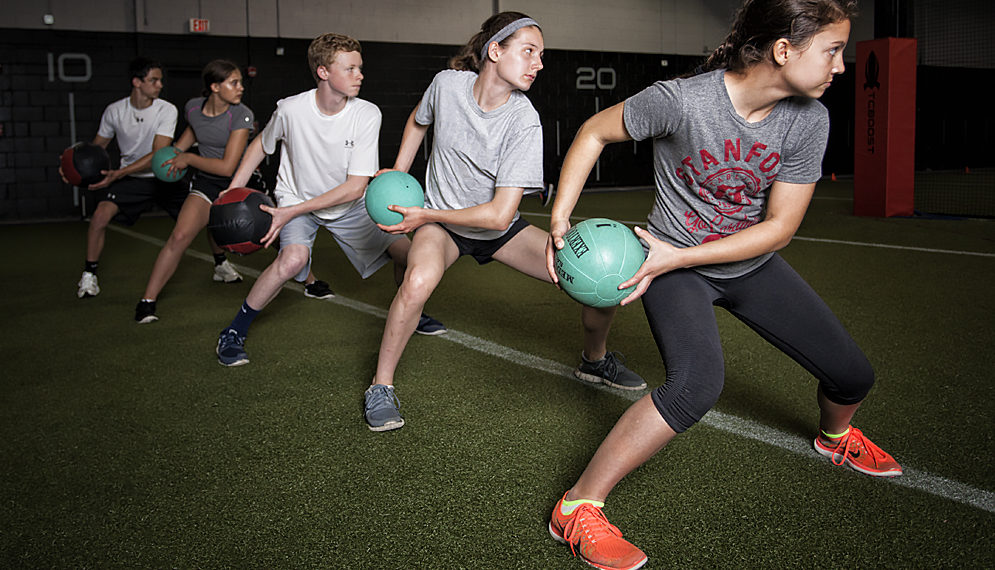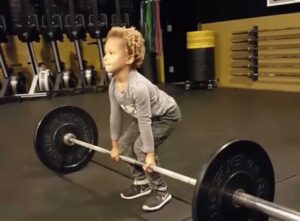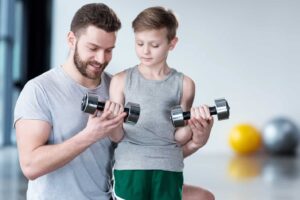
Where does Alex Morgan’s speed come from? How about Lebron’s power to dunk over the heads of 7ft + opponents? Sure, these athletes have an inborn talent placing them in the top 1% of their sport. But behind every athlete is a well-tailored strength and conditioning program that keeps them at the top of their game.
It’s the “behind the scenes” work that often separates the good from the great and the injured from the non-injured.
Youth athletes are no different and have shown positive responses to participating in a consistent strength program. Prior to puberty, kids have minimal androgens (testosterone) and Human Growth Hormone circulating through their system hindering their ability to grow muscle like adults are able to. However, kids can still benefit from strength training by way of improving neuromuscular activation.
Practicing activities that require great effort enhances the efficiency of muscle firing and improves gross motor coordination making power and strength appear greater than before. Learning basic fundamentals of everyday movements from a young age – such as squats and hip hinges – set the child up for success to begin building muscle mass once puberty does hit. Below we will dive deeper into the “why’s” and “how’s” of youth strength and conditioning programs.

Why are strength and conditioning important for youth athletes?
A young athlete who participates in a regular strength and conditioning program may have the upper hand in athletic performance compared to counterparts who simply show up to practice.
Zwolski et. al describes physical literacy as the “ability, confidence, and desire to be physically active for life,” a quality that can predict future health status and confidence in physical activity.
A sedentary lifestyle remains a large factor contributing to childhood obesity. On the other end of the spectrum lies young athletes who specialize in a specific sport from a young age and fall victim to overuse injuries. To counteract both of these consequences, a well-programmed strength and conditioning program can benefit all youth athletes. Among adolescents, approximately 50% of injuries are due to overuse scenarios. Strength training has been shown to reduce sports-related injuries (both acute and overuse) by 66%.
Most gains from a strength training program designed for pre-pubertal kids can be correlated to improved motor control (ability of your brain to fire the correct muscles at the correct time) rather than brute strength development. Once the child hits puberty and begins circulating androgens (testosterone) through their body, a 50% improvement in strength can be measured in as little as 8 weeks while participating in a strength program.
Developing confidence in strong functional movement patterns at an early age leads to greater physical literacy later in life.
What are the main muscle groups youth athletes should focus on strengthening?
Overuse injuries that plague youth soccer athletes at the highest frequency are tendinitis, patellofemoral pain and Osgood-Schlatter Disease (jumper’s knee). Sprains, strains and contusions of the ankles and knees are the most commonly reported acute injuries in youth soccer, with females being more prone to injury than males.
Among these acute injuries, ACL ruptures are unfortunately an injury young athletes – especially females – need to be wary of. Besides genetic biomechanical dispositions, females also tend to utilize the muscles on the front side of their legs (quadriceps) to a much greater degree than the muscles on the back side of the legs (glutes and hamstrings).
These preferences may lead to insufficient hip and knee bend, resulting in poor shock absorption when landing from a jump, decelerating or a sudden change in direction, predisposing them for greater risk for ACL tears.
For this reason, posterior chain strengthening and trunk stabilization exercises should be a focus of youth strength training programs. For more information on dynamic stretching and sport-specific warm ups, check out the ACL Prevention Program created by Seattle Pediatric Sports Medicine for youth athletes.

Are there any restrictions to strength training for youth athletes?
An age old myth that has deterred youth from strength training narrates that strength exercises place growth plates at risk for injury, resulting in stunted growth of the child. This has been proven false.
Dahab et. al reports the rare growth plate injuries that do occur during strength training have been due to misusing equipment, lifting inappropriately heavy loads, using poor form and training without supervision from a qualified fitness professional. Controlling these factors will not place dangerous stress on growth plates.
The pros of strength training far outweigh the cons for youth athletes.
The following guidelines are a good starting point to reduce risk of injury while training:
- 2 sets of 6-15 repetitions for each exercise (looking for muscle fatigue, NOT muscle failure)
- Total of 6-8 different exercises that target all major muscle groups (chest, shoulders, back, arms, legs, core)
- Start with big full body exercises, end with smaller single joint exercises
- Rest period of 1-3 minutes between each set
- Avoid training on consecutive days
- Use submaximal loads only and avoid any max strength testing (1 repetition max) until skeletal maturity has occurred


* First image is example of full body exercise, second image is example of single joint exercise
What should a strength and conditioning session look like for youth athletes?
The National Athletic Trainer’s Association has stated young athletes would benefit from implementing a strength training program 2 months before a sport season begins to allow for a gradual ramping of physical demands placed on tissues. What that training program looks like may depend on the stage of maturation the child is in. Kids who have not yet reached puberty likely incur athletic gains by means of improving neuromuscular connections and coordinated movement patterns. Lower levels of hormones limit how much a muscle may grow, however, we still see improvements in athletic abilities in this population following proper programming. Training with low load at high velocities has been shown to be most beneficial for building neural connections in pre-pubertal athletes.
Once the athlete hits puberty, training mechanisms shift into utilizing high load, low velocities to produce physiological changes in muscle fibers (i.e. grow, improve strength).
Recent literature has pointed to using approximately 80% of the athlete’s estimated 1-repetition max weight to facilitate muscle growth.
By placing tissues under a high load like this, tendons are also strengthened reducing risk of injury. The nature of the athlete’s sport should also be taken into account. To provide the greatest well-rounded approach to training, a youth athlete should incorporate both strength and power exercises into their program once they have reached puberty.
How do strength programs progress for youth athletes?
A good rule of thumb to base adolescent training on is to begin with bilateral (both sides) movements and transition to unilateral (one side) movements.
Bilateral exercises have been shown to improve strength and are correlated with faster sprint times. Unilateral exercises are shown to improve jumping/agility (change of direction) measures and overall body coordination. It is important to have a sufficient base-layer of strength before trying to improve agility.
These findings support the idea of specificity, or the notion that training specific aspects of a desired activity will improve the overall performance of the activity. For example, an athlete jumping off one leg to head a ball forward while on the run would benefit from single leg squats whereas an offensive lineman would benefit more from heavy double leg squats.


* First image is an example of unilateral exericse, second image is example of bilateral exercise.
Examples of strength exercises
Below are examples of some exercises utilizing many of the principles discussed above and formatted into a circuit-style workout for a young soccer athlete:
Jessica Hiestand DPT, CSCS

This post was written by Dr. Jessica Hiestand in January of 2023.
Learn more about Jessica on our about page: https://gopt.co/people/jessica-heistand/
References
- Andrew Watson, Jeffrey M. Mjaanes, COUNCIL ON SPORTS MEDICINE AND FITNESS, Cynthia R. LaBella, M. Alison Brooks, Greg Canty, Alex B. Diamond, William Hennrikus, Kelsey Logan, Kody Moffatt, Blaise A. Nemeth, K. Brooke Pengel, Andrew R. Peterson, Paul R. Stricker; Soccer Injuries in Children and Adolescents. Pediatrics November 2019; 144 (5): e20192759. 10.1542/peds.2019-2759
- Dahab KS, McCambridge TM. Strength training in children and adolescents: raising the bar for young athletes? Sports Health. 2009 May;1(3):223-6. doi: 10.1177/1941738109334215. PMID: 23015875; PMCID: PMC3445252.
- McQuilliam, S.J., Clark, D.R., Erskine, R.M. et al. Free-Weight Resistance Training in Youth Athletes: A Narrative Review. Sports Med 50, 1567–1580 (2020). https://doi.org/10.1007/s40279-020-01307-7
- Stern, Darren1; Gonzalo-Skok, Oliver2; Loturco, Irineu3; Turner, Anthony4; Bishop, Chris4. A Comparison of Bilateral vs. Unilateral-Biased Strength and Power Training Interventions on Measures of Physical Performance in Elite Youth Soccer Players. Journal of Strength and Conditioning Research 34(8):p 2105-2111, August 2020. | DOI: 10.1519/JSC.0000000000003659
- Zwolski C, Quatman-Yates C, Paterno MV. Resistance Training in Youth: Laying the Foundation for Injury Prevention and Physical Literacy. Sports Health. 2017;9(5):436-443. doi:10.1177/1941738117704153